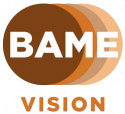about us
BAME Vision
BAME is an acronym which stands for communities of Black, Asian, and Minority Ethnic people.
BAME Communities make up 8.1 million people of the U.K. of which a high proportionate of people are blind or partially sighted and there is still a vast amount of people at risk of sight loss who are unaccounted for.
Our vision and values
The U.K. is dynamic and energetic, providing a broad range of opportunities and benefits. Here at BAME Vision, we aim to address and highlight issues related to BAME communities both for blind and partially sighted people and those at risk of sight loss, whilst ensuring that they can take advantage of the opportunities they are given in the same way anyone else would. BAME Vision is a group of member organisations in the eye health and sight loss sector represented by both professional experts and also by those with lived experience enabling us to work cohesively.
Our values and priorities
Increasing equality and diversity and working with all who share our vision and mission
We will pave the way in addressing the barriers and challenges which have been faced for decades
We will engage with everyone who is at risk of or has sight loss including their loved ones, with professionals and anyone wishing to make a difference
We will respect decisions made by individuals regarding their choices, boundaries and cultures
- Data and statistics and health economics including gaps in data
- Case studies
- Research papers
- Communications including helplines
- Educating communities, volunteers and staff on issues
- Reaching people through face to face contact within local community settings including community centres, places of worship etc. We will also deliver presentations and workshops and give talks on community radio stations and through online platforms.
- Awareness Raising
Talent development
- Volunteers
- Recruitment
- Staff & volunteer training
BAME Vision is on a mission to address the inequalities experienced by blind and partially sighted people and those at risk of sight loss from BAME and ethnically diverse communities.
